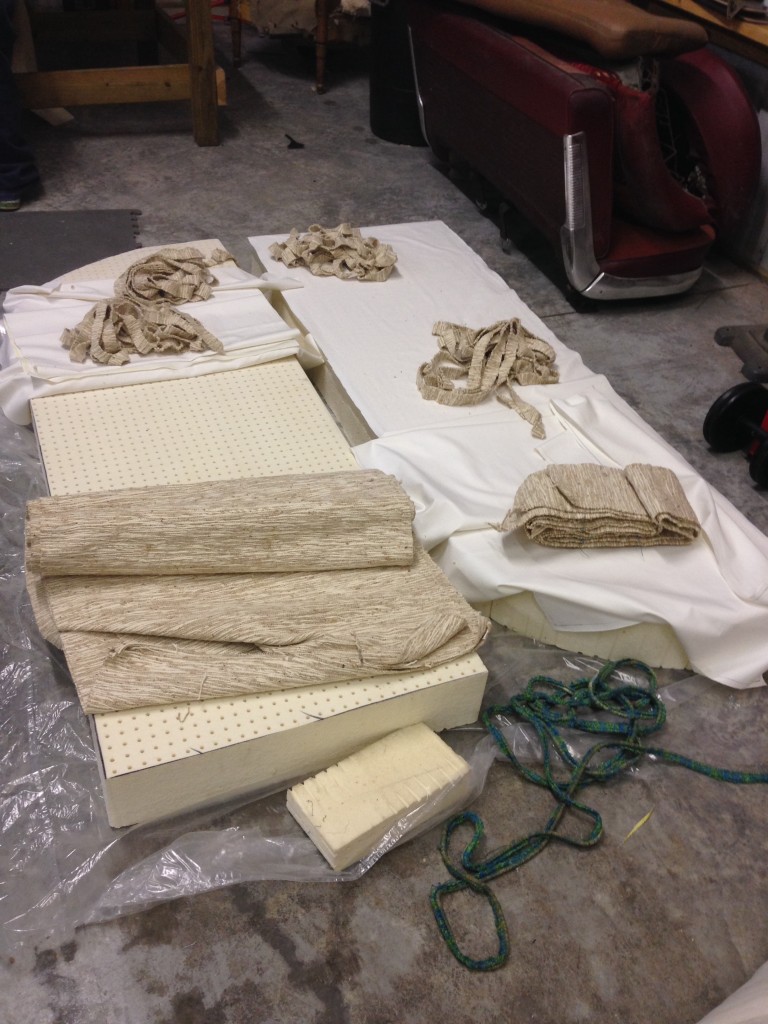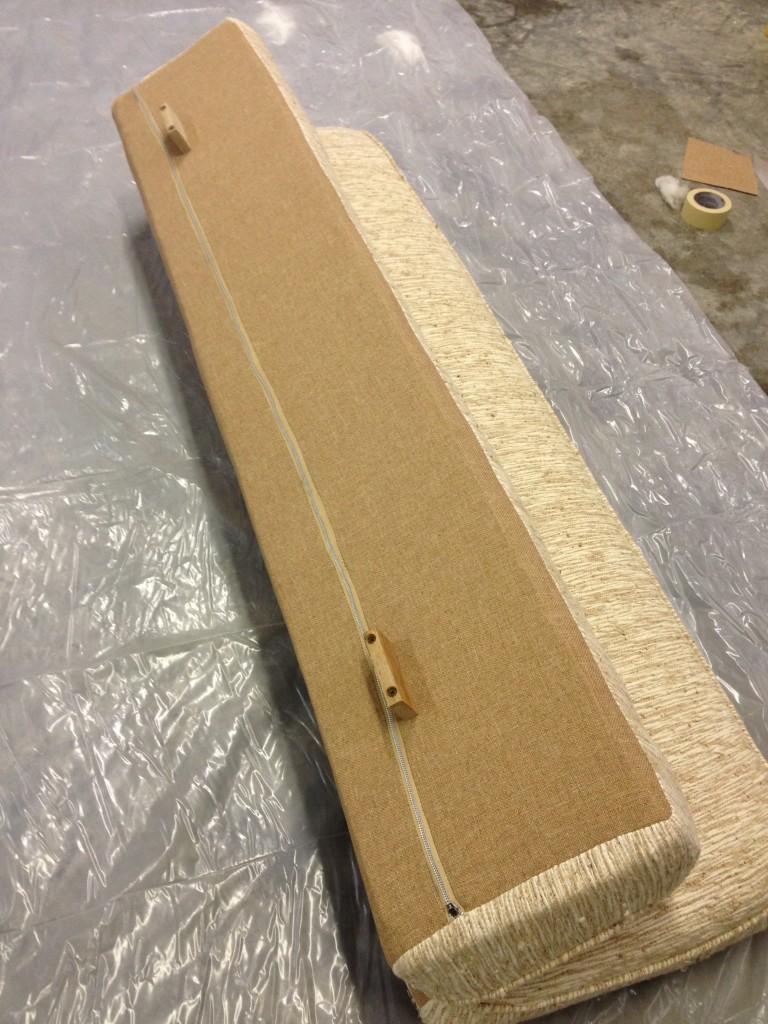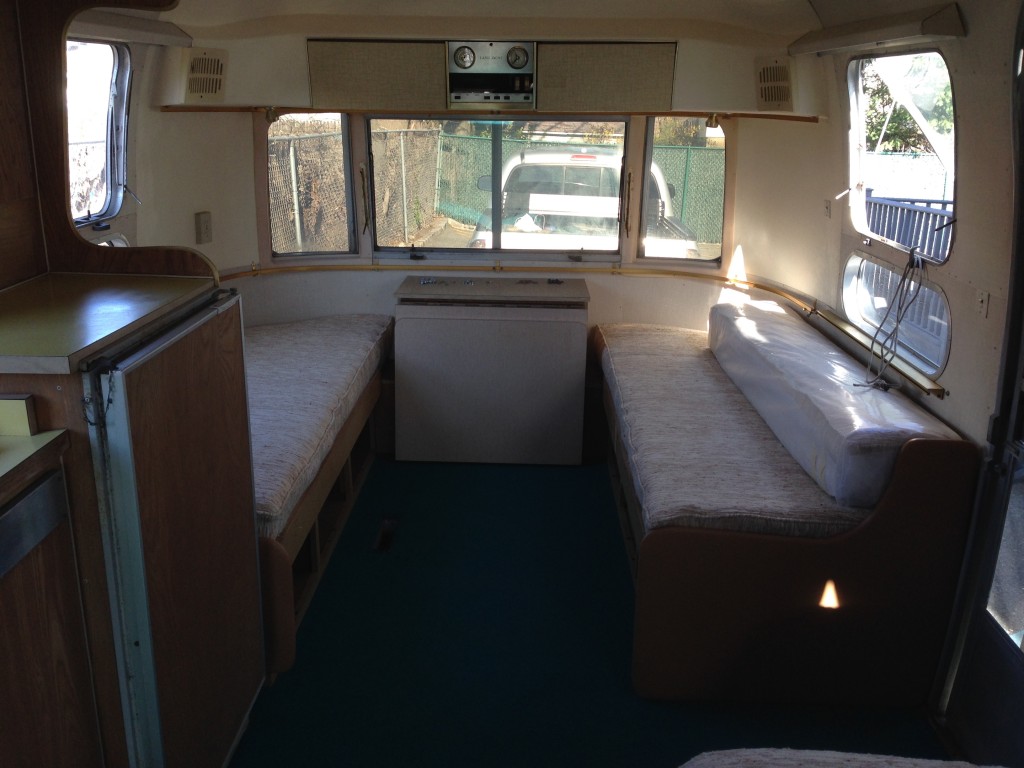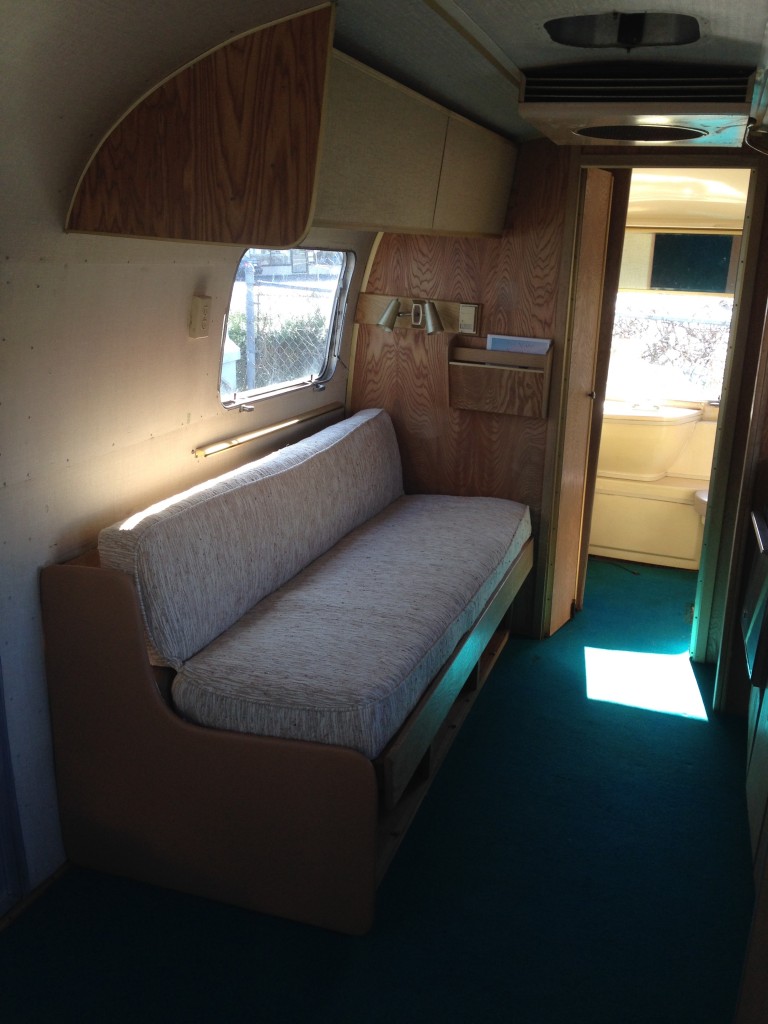I returned to North Carolina for a third time to help my family with a project, and was excited that by the end of my two week stay, my new Airstream cushions would finally be finished! I knew that before I made arrangements for their final pickup, I needed to touch base with the upholsterer to check on progress, review final pricing, and make a progress payment to help motivate his team to keep our schedule. I had already made an initial down payment that represented a little over a third of his estimate to get the ball rolling. Then, I delivered all of the materials to him in a timely fashion and made sure to confirm their arrival. The upholsterer then confirmed that by April 1st, my cushions would be finished.
So, I stopped by the shop three days before the deadline to take a look. Although I’d arrived a week earlier, this was the earliest they would accommodate a visit. The process had begun, with the materials roughly cut to size (using the original cushions as templates):

The L-shaped pieces that fit to the ends of the seats had already been covered with leather on one side (cloth matching the seats would be applied to the reverse):

They had discovered during this process that we didn’t have enough material to make the Dinette cushions reversible (as I’d hoped, in order to prolong their life), and that the largest L-shaped end didn’t quite have enough cloth either unless they pieced in an extra 2″ strip at the very bottom that wouldn’t exactly match. Since this area wouldn’t be seen once installed, I approved the changes so that we could proceed. At this point I felt that the upholsterers were making decent progress, and were willing to meet the deadline, so I asked about final pricing (reminding him that I was a referred customer).
Unfortunately, here is where we came to a conflict. The upholsterer shifted on his feet a few times, looked off into the distance and seemed to be doing some calculations in his head. Months earlier, we had come to a $700 – $800 rough estimate, which he’d warned me at the time was not firm. But he’d also told me that the price wouldn’t be very much higher. These numbers were based on a discussion of the construction method. I’d also delivered the materials to him and reviewed them with him in person well in advance, and there was no mention of any additional factors that would affect price.
I imagined that he would come up with $1,000 as his revised price, and was shocked when he came up with $1,500! Double the price!!! He’d used the construction process and extra reinforcement sewing needed for the type of fabric we were using as his justification. We sat down in his office and I made the following proposal:
Taking his highest preliminary estimate of $800, I would meet him in the middle between $800 and $1,500, which is $1,150. I told him that since the construction method hadn’t essentially changed since we’d first negotiated and the additional work he was proposing to reinforce the cloth wasn’t mentioned to me when we reviewed the material in person, I felt that $1,150 was fair. He actually admitted to me that he was fishing for the highest amount I would pay, and we finally agreed on $1,200 (which I later thought I should have made contingent on my review of the final product).
And with that, we were able to continue. Needless to say, this is not how I like to do business, and doubling my price without warning for no good reason just days before delivery for me is a huge red flag. I do plan to reach out to the folks who recommended him and give them a heads up. But I thought it best to reach a compromise I could live with as quickly as possible because, after all, they still had all of my materials and I needed to achieve my deadline. In my work as a construction project manager in Manhattan I’m used to working with contracts, and so without these, I’m counting on my experience to help me out here with smaller (and particularly specialty) vendors who typically do not, and are not used to having clients that are otherwise on task with deliveries and other communications. So in addition to due diligence, I’m finding that I have to practice making more savvy verbal agreements on the spot.
A couple of days later, it was time for me to pick up the finished cushions:


I was generally happy with the result; obviously some good work and experience went into the construction. My concerns with the finished product were that:
- The latex foam with wool batting were thicker than the original template, so the cushions appear overstuffed. I’ll be trusting Carla (who provided the materials) from Living Home Furniture’s advice that the batting will compress and everything will even out.
- A few pieces of hardware that I was told would be installed were not. Easy to do, but not what we agreed to up front.
On the upside, the upholsterers offered to bring the foam from the original cushions to one of their distributors for recycling, saving me a significant amount of time and research and keeping with the spirit of my project. I’ll assume in good faith that this will be done, only because it’s someone they work with regularly. I left them with a handshake, satisfied that I’d got something significant completed but disappointed in the way it was transacted.
After a long drive back to NY, I took some time to remove the original Airstream furniture frames, vacuum the floors and clean the interior walls with water & bleach so that I could install the cushions against clean surfaces – it took about 5 hours. Now, it looks like this: 
 The gaucho hardware on the cushions don’t quite line up with the existing hardware on the wall, so I’ll need to figure that out. Still, it’s fine to sit & sleep on. At the end of the day, I’m happy with the materials, and that the cushions are useable in place. Lessons learned! The saga continues…
The gaucho hardware on the cushions don’t quite line up with the existing hardware on the wall, so I’ll need to figure that out. Still, it’s fine to sit & sleep on. At the end of the day, I’m happy with the materials, and that the cushions are useable in place. Lessons learned! The saga continues…
Up next: Welding the Frame





Unfortunate bump in the road re the pricing as well as his lack of attention to detail about fitting of the hardware, but the installation of the cushions looks really fine.
This is completion of a major step in your reconstruction process. Congratulations!
Thank you! 🙂
It looks fantastic! Good enough to live in.
Curious why you used leather and not a synthetic.
Hi Edie, : )
Thanks for asking this question!
In keeping with the green design / build theme of this project, wherever practical I prefer to use all-natural products that are prepared or manufactured using ecologically friendly methods. I also was given an attractive price on the leather I ended up using, so that certainly played a part in my thinking!
During this process, I discovered that the areas that I’m installing leather were originally covered in pale mustard-colored Naugahyde (a synthetic leather-like product) – and it’s lasted the better part of 50 years in very good condition. So it’s arguable from both a purist vintage design perspective and a green building perspective that I should keep it installed & intact. But ultimately, the color and texture didn’t appeal to me and I couldn’t imagine putting a substantial amount of money into upholstering the cushions to match.
Leather, although it’s an organic product, is not necessarily manufactured using an eco-friendly process. I came across a sticker on the back of the leather that I’d somehow failed to see earlier has a few codes and clues that I can research to find out more about how the specific material I purchased was made.
Naugahyde, according to a recent material safety data (MSDS) sheet posted by the manufacturer, is produced using certain harmful products / methods that pose no danger to humans during the life & normal use of the product. I’m not sure if their proprietary formula or manufacturing methods have substantially changed since 1969. It may be that once the product is introduced to the landfill (as a small quantity of my materials just have), harmful materials are released or simply will not biodegrade. Or maybe the harmful aspects are front-loaded into the manufacturing process. I don’t know.
My design approach has been an attempt to re-upholster the trailer as I would have in 1969 given a clean slate and current eco-friendly materials & methods. And then I recycle the original materials to the best of my knowledge and ability.
Thanks for the thorough reply. Now I understand your mission more fully. The project is coming along beautifully. Love the pictures and the explanations.